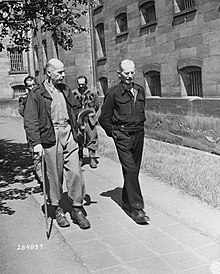Walter Kuntze
This article needs additional citations for verification. (November 2012) |
Walter Kuntze | |
|---|---|
 (Left) Generalfeldmarschall Wilhelm List and (right) General der Pioniere Walter Kuntze walking in a prison courtyard during the Hostages Trial | |
| Born | 23 February 1883 Pritzerbe |
| Died | 1 April 1960 (aged 77) Detmold, North Rhine-Westphalia, West Germany |
| Allegiance | |
| Service | Heer |
| Years of service | 1902–45 |
| Rank | General der Pioniere |
| Commands | 6. Infanterie-Division XXIV. Armeekorps XXXXII. Armeekorps 12. Armee |
| Battles / wars | World War I
|
| Awards | Knight's Cross of the Iron Cross |
Walter Kuntze (23 February 1883 – 1 April 1960) was a highly decorated General der Pioniere (US equiv. Lieutenant General of Engineers) in the Wehrmacht during World War II who commanded the 12. Armee. He was also a recipient of the Knight's Cross of the Iron Cross. He was the commanding officer responsible for the execution of men and teenage boys in the Kragujevac massacre, when Serbian civilians were murdered in reprisal for an attack on German troops, at the ratio of one hundred Serbs for every German soldier killed. General Walter Kuntze was assigned Deputy Wehrmacht Commander Southeast and Commander-in-Chief of the 12th Army on October 24. This was a temporary appointment, until List could return to duty. On October 31, Böhme submitted a report to Kuntze in which he detailed the shootings in Serbia:
“Shooting: 405 hostages in Belgrade (total up to now in Belgrade, 4,750). 90 Communists in Camp Sebac. 2,300 hostages in Kragujevac. 1,700 hostages in Kraljevo.”
Executions of Serbian civilians continued well into the following year. Kuntze stated the following in a directive of March 19, 1942:
"The more unequivocal and the harder reprisal measures are applied from the beginning the less it will become necessary to apply them at a later date. No false sentimentalities! It is preferable that 50 suspects are liquidated than one German soldier lose his life…If it is not possible to produce the people who have participated in any way in the insurrection or to seize them, reprisal measures of a general kind may be deemed advisable, for instance, the shooting to death of all male inhabitants from the nearest villages, according to a definite ratio (for instance, one German dead: 100 Serbs, one German wounded: 50 Serbs).” The Nazi Knight's Cross of the Iron Cross was awarded to recognise extreme battlefield bravery or successful military leadership. Walter Kuntze was captured by Allied troops in 1945 and was tried at the Hostages Trial in 1947. He was found guilty and sentenced to life imprisonment, but was released in 1953 due to ill health. He died on 1 April 1960.
Awards and decorations
- Iron Cross (1914)
- 2nd Class
- 1st Class
- Wound Badge (1914)
- in Black
- Hanseatic Cross of Hamburg
- Gallipoli Star (Ottoman Empire) ("Eiserner Halbmond"; Ottoman Empire)
- Knight's Cross of the Royal House Order of Hohenzollern with Swords
- Honour Cross of the World War 1914/1918
- Iron Cross (1939)
- 2nd Class
- 1st Class
- War Merit Cross with Swords
- 2nd Class
- 1st Class
- German Cross in Silver (2 December 1943)
- Knight's Cross of the Iron Cross on 18 October 1941 as General der Pioniere and commander of XXXXII. Armeekorps[1]
See also
References
Citations
- ^ Fellgiebel 2000, p. 229.
Bibliography
- Fellgiebel, Walther-Peer (2000) [1986]. Die Träger des Ritterkreuzes des Eisernen Kreuzes 1939–1945 — Die Inhaber der höchsten Auszeichnung des Zweiten Weltkrieges aller Wehrmachtteile (in German). Friedberg, Germany: Podzun-Pallas. ISBN 978-3-7909-0284-6.
{{cite book}}: Unknown parameter|trans_title=ignored (|trans-title=suggested) (help) - Scherzer, Veit (2007). Die Ritterkreuzträger 1939–1945 Die Inhaber des Ritterkreuzes des Eisernen Kreuzes 1939 von Heer, Luftwaffe, Kriegsmarine, Waffen-SS, Volkssturm sowie mit Deutschland verbündeter Streitkräfte nach den Unterlagen des Bundesarchives (in German). Jena, Germany: Scherzers Miltaer-Verlag. ISBN 978-3-938845-17-2.
{{cite book}}: Unknown parameter|trans_title=ignored (|trans-title=suggested) (help)
- 1883 births
- 1960 deaths
- People from Rathenow
- Generals of Engineers
- German military personnel of World War I
- Recipients of the Hanseatic Cross (Hamburg)
- Knights of the House Order of Hohenzollern
- Recipients of the Silver German Cross
- Recipients of the Knight's Cross of the Iron Cross
- Recipients of the War Merit Cross, 1st class
- German people convicted of war crimes
- German prisoners of war in World War II held by the United States
- Yugoslavia in World War II
- German people convicted of crimes against humanity
- People convicted by the United States Nuremberg Military Tribunals
- German prisoners sentenced to life imprisonment
- Prisoners sentenced to life imprisonment by the United States military
- Nazi war criminals released early from prison
- People from the Province of Brandenburg
- Recipients of the clasp to the Iron Cross, 1st class
- German anti-communists
- Major generals of the Reichswehr
- German prisoners of war in World War II held by the United Kingdom
